Canary Colors
Canary colors are green and yellow naturally. However, after breeding and pairing different varieties of canaries with some color food, canary colors are now Yellow, Green, White, Red, Orange, Dark Blue, and even Black.
Due to various color patterns mating and mutation, canaries have now a variety of colors that make this beautiful bird more outstanding.
What is a Canary Bird?
T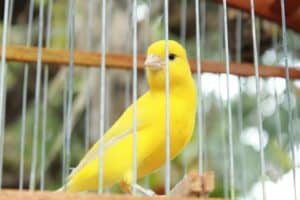
The Canary bird breed is different from other pet birds such as parrots and cockatiels. They have the same name but different parents. The canaries are from the Finch family. They are very small pet bird that is often confused with a parrot. There are several different breeds of canaries. The most common types of canaries are Green, Yellow, White, Orange, and Red.
Before we get into the different colors of the canaries, just check the history and background of canaries, their varieties, and color combinations.
The Original Breed and Color of Canary
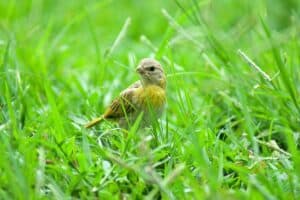
Family Group of Canary Bird
The finch family has been divided into two groups: the chaffinches (Fringillidae) and the canaries and budgerigars (Serinidae). The canary-budgerigar group is in turn divided into two subgroups: the canary group (Serinus) and the budgerigar group (Melopsittacus, Cacatua, and Lichenostomus).
The Serinus are further divided into two subgroups: the domestic canary (Serinus domesticus) and the rock canary (Serinus sinaloae). The rock canary is considered by some to be a subspecies of the domestic canary. However, there is no molecular evidence or clear morphological evidence of this.
The rock canary is found in several subspecies or variants in the Canary Islands, the most common of which is Serinus sinaloae. This subspecies was originally considered a separate species, and was later declared a subspecies of the domestic canary.
Different Colour Factors in the Canaries
According to the “Introduction to the Color Canary” by J.M. Nelson, 1989, likely hundreds of accidental pairings of wild canaries eventually resulted in the typical clear yellow bird as opposed to the highly-pigmented, grayish-green bird of domesticated canaries. After that, birds progressively started being produced in color, with white, blue, and fawn rare specimens appearing later.
As the 1900s dawned, these canaries became colored so that white, blue, and fawn higher colorations occurred. And later in 1995, the first male red-sided grosbeak (but let’s not get into that discussion) struck a deal with a red canary to produce an offspring.
The color canary, like all other canaries, is a captive-bred variety. It is an American breed developed by the American Poultry Association. The first color canary was registered in 1900.
What is a Color canary?
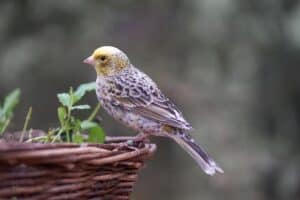
Its plumage is a dark olive-brown, except for the head, which is streaked with vivid yellow. As a result of this striped plumage, the bird is sometimes called the striped canary or the striped bunting.
The color canary is active and alert and is excellent for beginners. The color canary has a friendly manner and is cheerful and is a good bird for apartment use.
What genes determine the color of a wild canary depends on its birth region and how its parents are related to each other. The wild canary’s yellow color is created by using melanin color (the melanin dark hues of black and brown), plus the lipochrome color (light yellow, deep yellow, and white). Coloring the scheme, the canary is an impressive combination of yellow and black.
If you breed canaries whose pigmentation includes the black melanin pigment, you might produce a canary with green-like color, but they would more likely turn brown. There is evidence that the artist Van Gogh, who killed himself, as well as his friend Therese Gaband, whose writing largely explains his mental illness, had a canary named Blanch climbing over a post in their Brussels apartment in 1888. The canaries with various degrees of blue had been “forty-odd” years previously, based on British research, according to our data on Van Gogh exploration.
In some cases, quahck breast chicks, especially those from lines that have light energy colors, are fed food or bacteria to enhance high little color. This task is called color-feeding and should be started before the bird molts at six (sometimes eight) weeks. The process may be thought of as adding lemon juice to bring out the blonde highlights in your blonde head of wonders.
Canary Colors | What color are Canaries?
The wild Canaries tend to be small, often measuring between 140 and only 160mm (5.5 and 6 inches). As is true of many birds, the color pattern is decided by what color of melanin they have in their feathers.
The darker brown melanin leads to a yellowish background color, which is then decorated with black and shades of tan. By contrast, the extensively studied domestic honey Canary D (Canaris hudsonius) has mostly white bases on its feathers, with some yellow rings and black accents.
Canary Bird Colors
There are various canary colors available, however, we will cover some most important and basic canary bird colors which are green, yellow, white, red, and orange.
The Green Canary
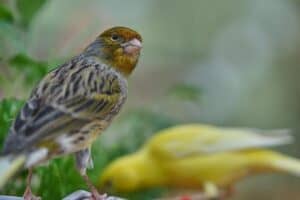
It was the wild canary color i.e. green, and yellow, which then further resulted in various canary colors.
The green canaries have high singing quality. They sing so aggressively and continuously than any other color of canaries. The reason behind this might be the natural color or genetic history of this breed.
You might have observed and experienced that green color canary sings more often without stopping than yellow or white canaries.
I have personally seen that my green canaries sing nonstop and have a higher rate of singing.
The Yellow Canary ( Canary Colors )

The yellow canary used to be in three colors in the wild. The origin of this yellow canary is a wild green canary. It used to have dark brownish or green feathers on the back and tail and dark yellow on the head and chest side.
Now the light yellow canary is the result of continuous breeding with different breeds. However, this yellow canary is widely kept as a pet for its beautiful singing quality and bright color.
Want to know more about this canary color Yellow, Check out this detailed article on Yellow Canaries.
The White Canaries (Canary Colors)
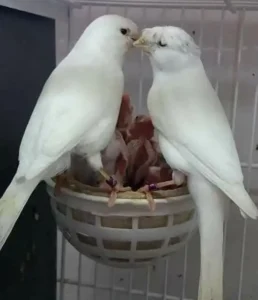
The white canaries have pure white plumage with the domination of white. The white canaries have dark eyes or light red/pink eyes. The genetic mutation of white canaries affects the white canaries.
These canaries are also very beautiful-looking albino canaries known for their beauty and singing as well. However, the average singing of white canaries is less than yellow or greenish canaries.
To learn more about the white canaries, just check the details article on the White Canaries
The white Canaries can be any color of the rainbow, not just white! White is a mutation of the red pigment in lipochrome (Ino-Factor) red, so a white Canary is essentially a red Canary with no melanin. The pigment is present in the eye, but there is no color to see the white Canaries
The three different base colors give rise to many different colors, and there are many different patterns on top. The most common colors are the green, orange, white, red, and yellow varieties, but there are many more.
Read here about the White Canaries
The Red Canary (Canary Color) / Red Factor Canary
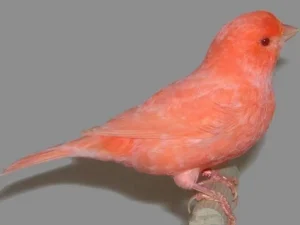
The red factor canaries are fed with color feed when the canary is 3 to 6 weeks old. Most of the time, breeders feed a white or yellow canary with color feed while they are in molting season.
But, the success rate of chick canaries is much higher than that of adult canaries.
The red factor canaries are famous for their showing purpose. In addition, these canaries sing very well. However, when they are paired with the same breed, it’s possible to have light red/orange color chicks.
To know more about the red factor canaries, just check out the detailed articles on The Red factor canaries or Red Canaries
The Orange Canaries (Canary Colors)
T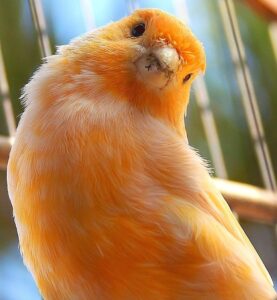
The orange canary is also a beautiful canary. The singing quality of this bird is also outstanding. It is not only known as a display pet but, it is also a quality singer bird.
The orange canary comes with light orange and dark orange plumage as well. If this canary is paired with the same color as the canary, the chicks are expected to be orange in color. Unless the history of the pair is continued in the same manner.
Blue Factor Canary | Blue Canary Bird
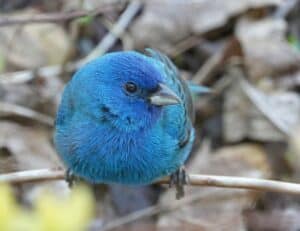
Blue factor canary birds are very rare and not available easily as pets. But, they are lovely canary birds and sing very beautifully.
Want to read more about blue canaries or Blue factor canary Birds Click Here
Canary Color
Canary color comes in these varieties which look very attractive and beautiful. Varieties in canary color, attract bird lovers to opt for a canary bird in different colors.
These were the canary colors that are widely available and seen in mutation with other colors. However, there are other color combinations of the canaries as well which are resultant of these basic colors.
Hope now you have known the basic canary colors and their different types. Let’s know which color of canary you have as a pet.

